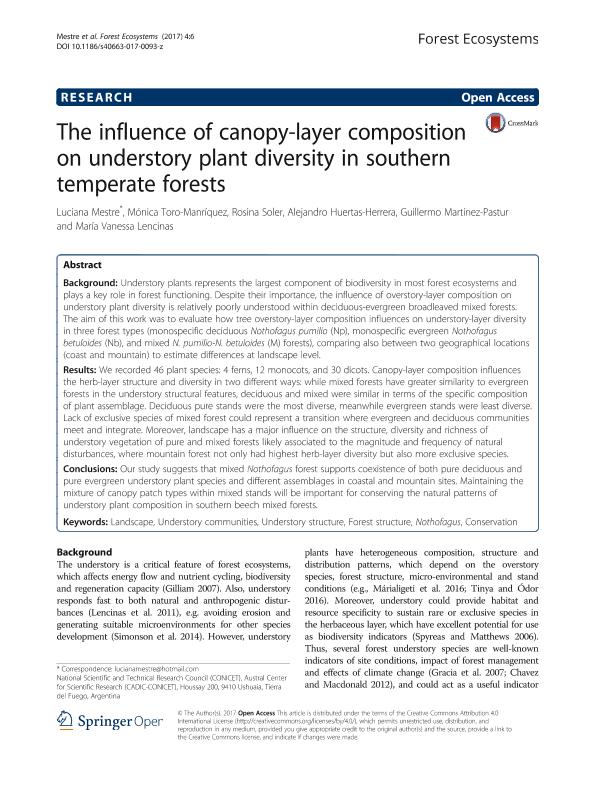Mostrar el registro sencillo del ítem
dc.contributor.author
Mestre, Luciana Mariel

dc.contributor.author
Toro Manríquez, Mónica del Rosario

dc.contributor.author
Soler Esteban, Rosina Matilde

dc.contributor.author
Huertas Herrera, Alejandro

dc.contributor.author
Martínez Pastur, Guillermo José

dc.contributor.author
Lencinas, María Vanessa

dc.date.available
2018-11-01T14:03:26Z
dc.date.issued
2017-05
dc.identifier.citation
Mestre, Luciana Mariel; Toro Manríquez, Mónica del Rosario; Soler Esteban, Rosina Matilde; Huertas Herrera, Alejandro; Martínez Pastur, Guillermo José; et al.; The influence of canopy-layer composition on understory plant diversity in southern temperate forests; Springer; Forest Ecosystems; 4; 6; 5-2017; 1-13
dc.identifier.issn
2197-5620
dc.identifier.uri
http://hdl.handle.net/11336/63421
dc.description.abstract
Background Understory plants represents the largest component of biodiversity in most forest ecosystems and plays a key role in forest functioning. Despite their importance, the influence of overstory-layer composition on understory plant diversity is relatively poorly understood within deciduous-evergreen broadleaved mixed forests. The aim of this work was to evaluate how tree overstory-layer composition influences on understory-layer diversity in three forest types (monospecific deciduous Nothofagus pumilio (Np), monospecific evergreen Nothofagus betuloides (Nb), and mixed N. pumilio-N. betuloides (M) forests), comparing also between two geographical locations (coast and mountain) to estimate differences at landscape level. Results We recorded 46 plant species: 4 ferns, 12 monocots, and 30 dicots. Canopy-layer composition influences the herb-layer structure and diversity in two different ways: while mixed forests have greater similarity to evergreen forests in the understory structural features, deciduous and mixed were similar in terms of the specific composition of plant assemblage. Deciduous pure stands were the most diverse, meanwhile evergreen stands were least diverse. Lack of exclusive species of mixed forest could represent a transition where evergreen and deciduous communities meet and integrate. Moreover, landscape has a major influence on the structure, diversity and richness of understory vegetation of pure and mixed forests likely associated to the magnitude and frequency of natural disturbances, where mountain forest not only had highest herb-layer diversity but also more exclusive species. Conclusions Our study suggests that mixed Nothofagus forest supports coexistence of both pure deciduous and pure evergreen understory plant species and different assemblages in coastal and mountain sites. Maintaining the mixture of canopy patch types within mixed stands will be important for conserving the natural patterns of understory plant composition in southern beech mixed forests.
dc.format
application/pdf
dc.language.iso
eng
dc.publisher
Springer

dc.rights
info:eu-repo/semantics/openAccess
dc.rights.uri
https://creativecommons.org/licenses/by-nc-sa/2.5/ar/
dc.subject
Landscape
dc.subject
Understory Communities
dc.subject
Understory Structure
dc.subject
Forest Structure
dc.subject
Nothofagus
dc.subject
Conservation
dc.subject.classification
Agricultura

dc.subject.classification
Agricultura, Silvicultura y Pesca

dc.subject.classification
CIENCIAS AGRÍCOLAS

dc.title
The influence of canopy-layer composition on understory plant diversity in southern temperate forests
dc.type
info:eu-repo/semantics/article
dc.type
info:ar-repo/semantics/artículo
dc.type
info:eu-repo/semantics/publishedVersion
dc.date.updated
2018-10-19T15:05:06Z
dc.journal.volume
4
dc.journal.number
6
dc.journal.pagination
1-13
dc.journal.pais
Alemania

dc.journal.ciudad
Berlin
dc.description.fil
Fil: Mestre, Luciana Mariel. Consejo Nacional de Investigaciones Científicas y Técnicas. Centro Austral de Investigaciones Científicas; Argentina
dc.description.fil
Fil: Toro Manríquez, Mónica del Rosario. Consejo Nacional de Investigaciones Científicas y Técnicas. Centro Austral de Investigaciones Científicas; Argentina
dc.description.fil
Fil: Soler Esteban, Rosina Matilde. Consejo Nacional de Investigaciones Científicas y Técnicas. Centro Austral de Investigaciones Científicas; Argentina
dc.description.fil
Fil: Huertas Herrera, Alejandro. Consejo Nacional de Investigaciones Científicas y Técnicas. Centro Austral de Investigaciones Científicas; Argentina
dc.description.fil
Fil: Martínez Pastur, Guillermo José. Consejo Nacional de Investigaciones Científicas y Técnicas. Centro Austral de Investigaciones Científicas; Argentina
dc.description.fil
Fil: Lencinas, María Vanessa. Consejo Nacional de Investigaciones Científicas y Técnicas. Centro Austral de Investigaciones Científicas; Argentina
dc.journal.title
Forest Ecosystems
dc.relation.alternativeid
info:eu-repo/semantics/altIdentifier/url/http://forestecosyst.springeropen.com/articles/10.1186/s40663-017-0093-z
Archivos asociados
